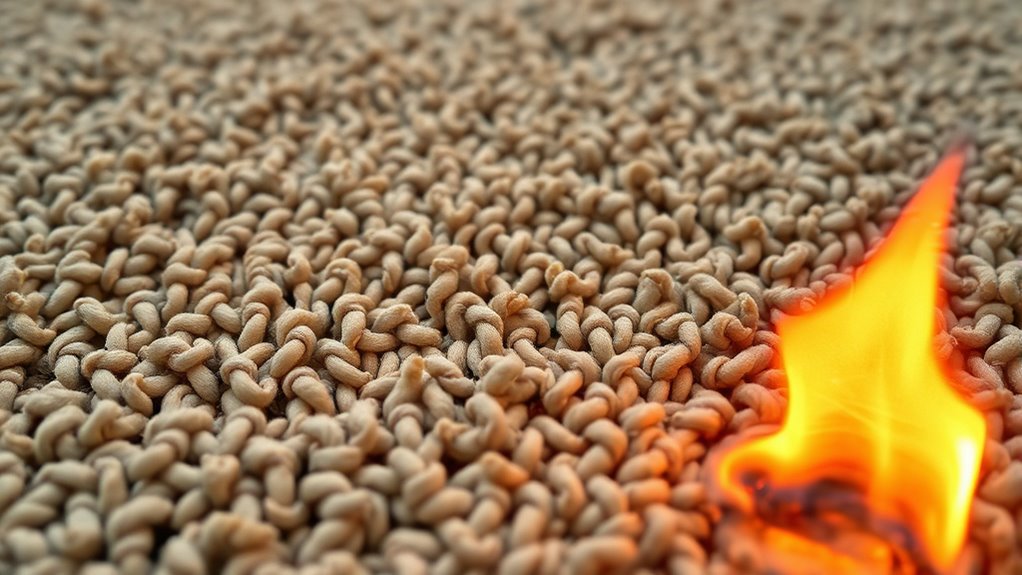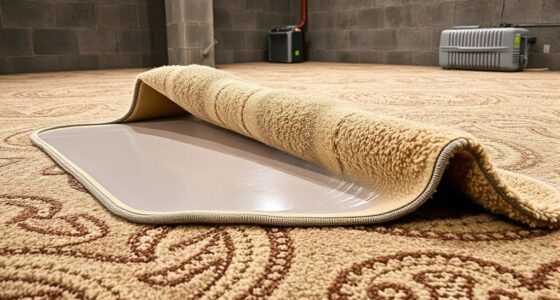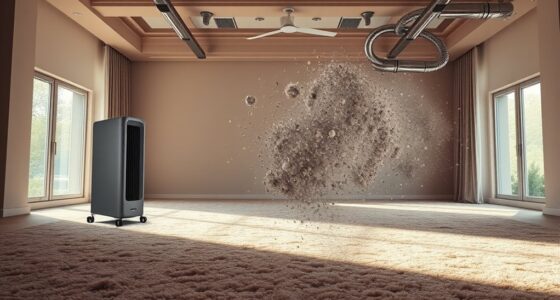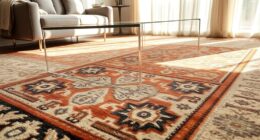Fire resistance ratings for commercial-grade carpets show how well they resist ignition, flame spread, and smoke development. These ratings, often classified as Class I, II, or III, depend on standardized tests like ASTM E648 and UL 94, and are influenced by fiber type, construction, and flame-retardant treatments. Choosing carpets with proper fire safety labels helps guarantee compliance and safety. Continue exploring to understand how these ratings impact your choices and safety standards.
Key Takeaways
- Fire resistance ratings like Class I, II, or III indicate a carpet’s ability to resist ignition and flame spread, based on local standards.
- Standardized tests such as ASTM E648 and NFPA 269 evaluate flame spread, smoke development, and ignitability to determine fire resistance.
- Fiber type (nylon, polyester, wool) and construction influence fire ratings, with wool naturally more fire-resistant than synthetic fibers.
- Fire safety labels and certifications provide essential information on a carpet’s compliance with fire resistance standards.
- Regular maintenance and proper cleaning help preserve the fire-resistant properties and ensure ongoing compliance with safety regulations.
Understanding Fire Resistance Classifications for Carpets

Understanding fire resistance classifications for carpets is crucial to guarantee safety in both residential and commercial spaces. These classifications help you determine how well a carpet can withstand heat and resist ignition. Carpets are rated based on their ability to delay fire spread and reduce smoke production, which is vital during emergencies. When selecting a carpet, look for labels indicating its fire resistance level, such as Class I, II, or III, depending on local standards. Keep in mind that higher-rated carpets offer better protection and are often required in public buildings and high-traffic areas. Additionally, some models of electric dirt bikes feature fire-resistant components, adding an extra layer of safety in environments where fire risk is a concern. By understanding these classifications, you can make informed decisions to ensure safety, compliance with regulations, and peace of mind for everyone using the space.
The Testing Procedures for Fire Resistance Ratings
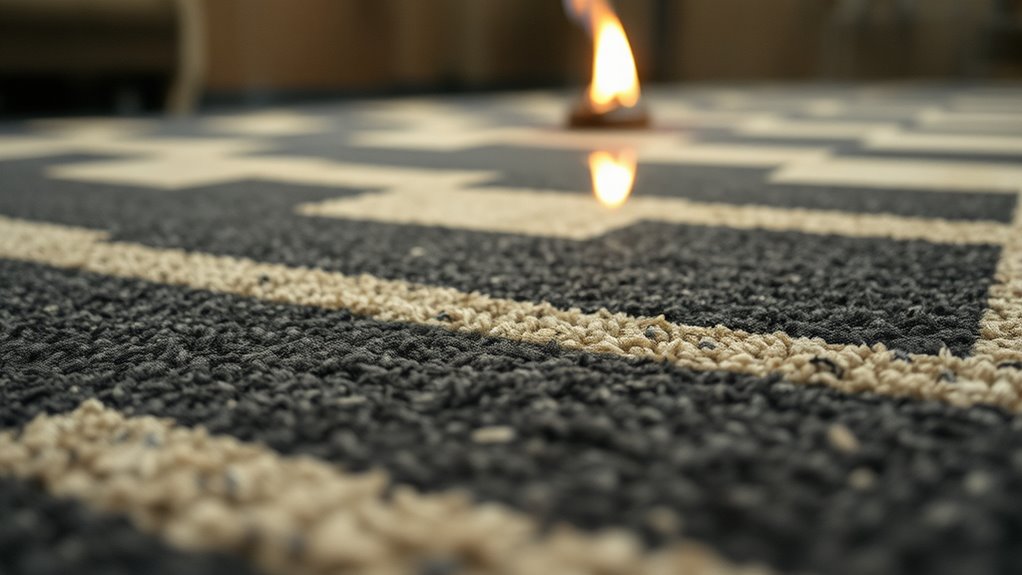
To determine fire resistance ratings, testing labs follow standardized methods that guarantee consistency. These tests evaluate flame spread, ignitability, and smoke production to assess how materials perform under fire conditions. Understanding these procedures helps you grasp how fire resistance ratings are reliably established. Additionally, the safety features of materials, such as the use of fire-resistant fibers, play a crucial role in their overall fire performance.
Standardized Testing Methods
Standardized testing methods are essential for determining fire resistance ratings because they provide consistent, repeatable procedures to evaluate how building components perform under fire conditions. These tests follow strict protocols established by organizations like ASTM and UL, ensuring that results are reliable and comparable across different products. During testing, samples are subjected to controlled fire exposures that simulate real-world scenarios, measuring parameters such as heat transfer, structural integrity, and smoke production. For carpets, the focus is on how they behave when exposed to fire, including ignition resistance and flame spread potential. Additionally, these methods assess the flammability properties of materials to ensure safety standards are met. By adhering to these standardized methods, manufacturers and building officials can confidently assess a carpet’s fire safety performance. This consistency helps establish accurate fire resistance ratings, supporting safer building designs and compliance with fire safety codes.
Flame Spread Assessment
Flame spread assessment involves specific testing procedures designed to measure how quickly and extensively flames propagate across a material’s surface. During testing, you expose a sample of the carpet to a controlled flame source in a standardized chamber. You observe how the flames spread along the surface, recording the distance traveled over a set period. The primary goal is to determine the material’s flame spread rating, which indicates its potential fire hazard. You must guarantee consistent test conditions, such as airflow, temperature, and sample size, to obtain accurate results. This assessment helps identify carpets that resist rapid flame spread, contributing to safer building environments. Understanding this process allows you to select fire-resistant carpets that meet safety standards and reduce fire risks. Additionally, maintaining proper testing conditions ensures reliable results and accurate fire resistance ratings.
Ignitability and Smoke Production
After evaluating how quickly flames spread across a material’s surface, the next step is to assess how easily it ignites and the amount of smoke it produces during a fire. You’ll conduct specific tests, such as the ASTM E1353 or NFPA 265, to measure ignitability. These tests determine how readily the carpet ignites when exposed to a heat source. Smoke production is equally critical, as excessive smoke can hinder evacuation and cause health hazards. During testing, you’ll observe the quantity and toxicity of smoke generated. Materials that ignite easily or produce thick, toxic smoke receive lower fire resistance ratings. Understanding these factors helps you select carpets that minimize fire risks, improving safety by reducing ignition likelihood and limiting smoke hazards during a fire event. Properly evaluating fire resistance ratings ensures the safety and compliance of commercial-grade carpets in various settings.
Key Factors Affecting Fire Performance of Commercial Carpets

The fire performance of commercial carpets depends on several key factors that influence how they react in fire situations. First, the fiber type plays a vital role; synthetic fibers like nylon and polyester tend to melt or drip, spreading flames quickly, while wool is naturally fire-resistant. Second, the carpet’s construction—whether it’s loop pile or cut pile—affects how flames and heat penetrate. Third, the backing material impacts fire spread and smoke production; flame-retardant backings can slow down ignition. Fourth, the presence of flame-retardant treatments on fibers can considerably improve fire resistance. Fifth, the density and thickness of the carpet influence how easily fire can spread across the surface. Additionally, unique and wicked planters can be used to enhance indoor spaces and may include fire-resistant materials, further contributing to overall safety. All these factors combined determine a carpet’s overall fire safety performance in commercial settings.
Interpreting Fire Resistance Labels and Documentation
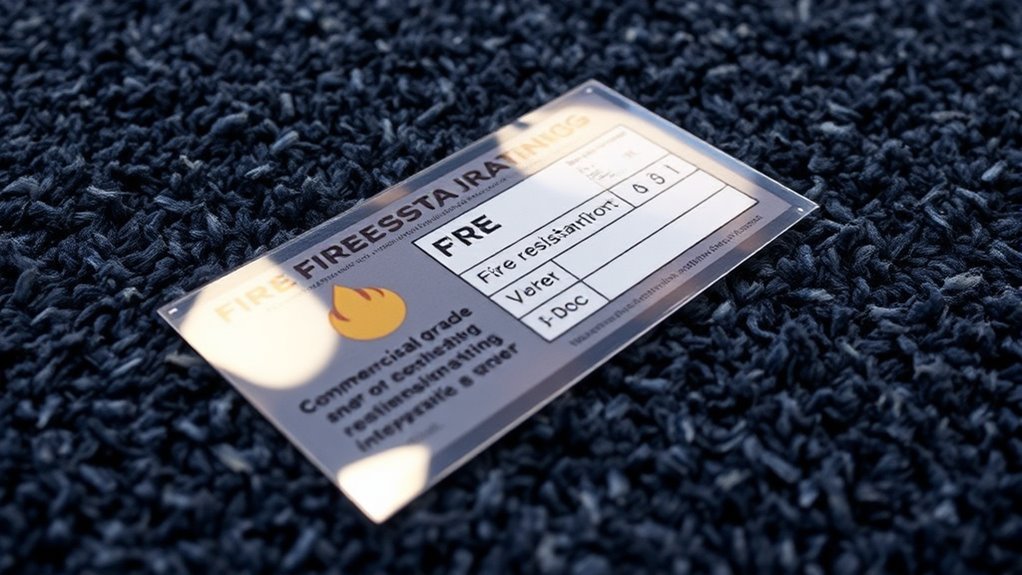
Understanding fire resistance labels and documentation is essential for selecting safe commercial carpets. These labels provide key information about a carpet’s fire performance, including fire ratings, testing standards, and compliance details. When reviewing labels, look for specific markings like the ASTM E648 or NFPA 253 ratings, which indicate flame spread characteristics. Documentation often includes test reports and certification numbers, allowing you to verify the carpet’s fire safety credentials. Be attentive to symbols and codes that specify the type of fire resistance, such as Class I or Class II. Accurate interpretation helps ensure you meet building safety requirements and select carpets that will perform reliably during a fire. Always cross-reference labels with official standards to confirm the carpet’s fire resistance and compliance. Additionally, understanding fire resistance ratings can assist in creating a safer environment by choosing materials that meet the necessary safety thresholds.
Standards and Regulations Governing Fire Safety in Commercial Flooring
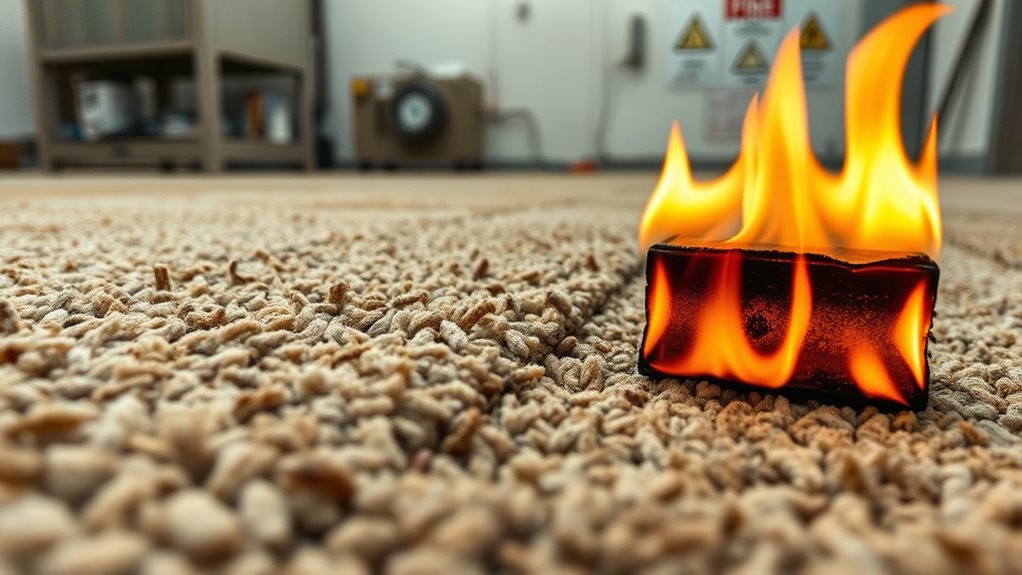
You need to understand the fire safety codes that set the requirements for commercial flooring. Compliance testing standards guarantee that materials meet safety criteria before approval. Knowing these regulations helps you choose flooring that keeps your space safe and compliant. Additionally, selecting materials with appropriate fire resistance ratings can significantly improve overall safety in commercial environments.
Fire Safety Codes
Have you ever wondered how commercial flooring materials are kept safe from fire hazards? Fire safety codes establish the rules and standards that manufacturers and building owners must follow to reduce fire risks. These codes specify requirements for flame spread, smoke development, and ignition resistance, ensuring flooring materials meet safety benchmarks. They are developed by organizations like the International Building Code (IBC) and National Fire Protection Association (NFPA). Local authorities enforce these regulations, which often mandate fire-resistant treatments or specific materials for commercial spaces. Compliance helps prevent fires from spreading rapidly and gives occupants more time to evacuate. Staying aware of these codes guarantees your flooring installations meet legal safety standards, protecting lives, property, and your business from fire-related damages. Incorporating fire-resistant materials can further enhance safety and adherence to regulations.
Compliance Testing Standards
Compliance testing standards are essential to guarantee that commercial flooring materials meet established fire safety requirements. These standards specify how products should be tested to assess their fire behavior, ensuring consistency and reliability. When selecting carpets, you need to verify they meet standards like ASTM E648 or NFPA 269, which evaluate critical factors such as flame spread and smoke density. Testing procedures involve exposing materials to controlled fire conditions and measuring their responses. Compliance with these standards is vital for certification, insurance, and safety compliance. By understanding these testing protocols, you ensure that the carpets you choose are safe for your environment and meet legal requirements. Always check product labels and documentation to confirm they meet the relevant standards for fire resistance.
Comparing Fire Resistance Ratings Among Different Carpet Materials

When evaluating different carpet materials, understanding their fire resistance ratings is essential for ensuring safety and code compliance. Different materials, like nylon, polyester, and wool, have varying fire-resistant properties. Nylon carpets often have higher ratings due to their flame-retardant treatments, making them suitable for high-traffic areas. Polyester carpets typically have lower ratings but can be treated to improve fire resistance. Wool naturally possesses flame-retardant qualities, which can contribute to higher ratings without added treatments. Keep in mind that ratings are determined through standardized tests, such as ASTM E648 or UL 94, and can vary depending on the manufacturing process. Comparing these ratings helps you choose the right material for your space, balancing safety, durability, and cost effectively.
Practical Tips for Selecting Fire-Resistant Commercial Carpets
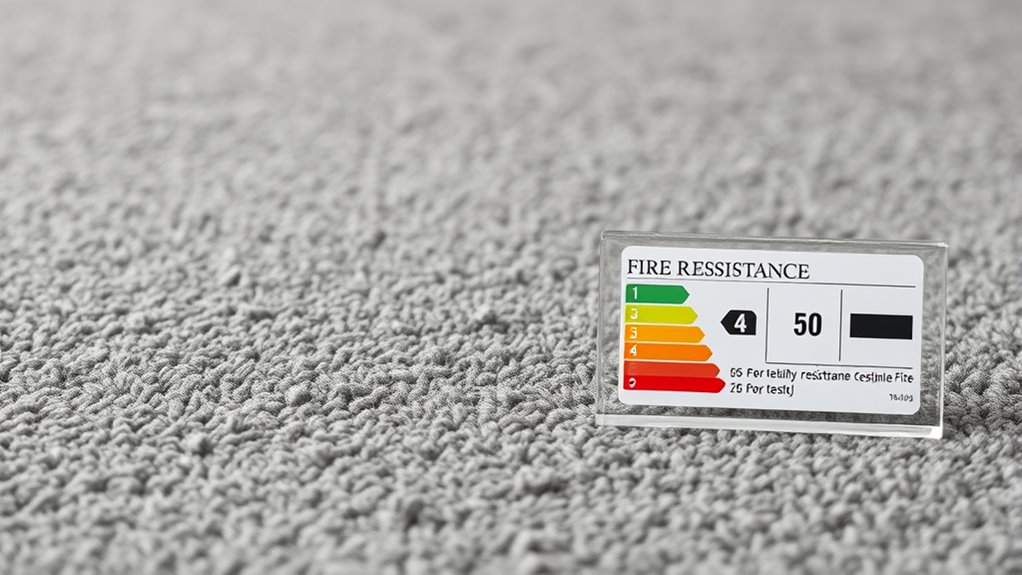
Choosing the right fire-resistant commercial carpet involves verifying several practical factors to ensure safety and suitability for your space. First, check the carpet’s fire resistance rating, ensuring it meets or exceeds local building codes and standards. Consider the carpet’s material; synthetic fibers like nylon or polypropylene typically perform well in fire resistance. Evaluate the carpet’s thickness and density, as denser carpets tend to resist flames better. Also, look at the backing and adhesive materials used, since these can influence overall fire safety. Don’t forget to verify if the carpet has been tested by a recognized fire safety testing organization. Additionally, understanding the fire resistance benefits of various carpet materials can help you make a more informed choice. Finally, assess the environment where the carpet will be installed—high-traffic areas may require more durable, fire-resistant solutions. These practical steps help you select a safe, compliant carpet for your space.
Maintenance and Care to Preserve Fire Safety Features
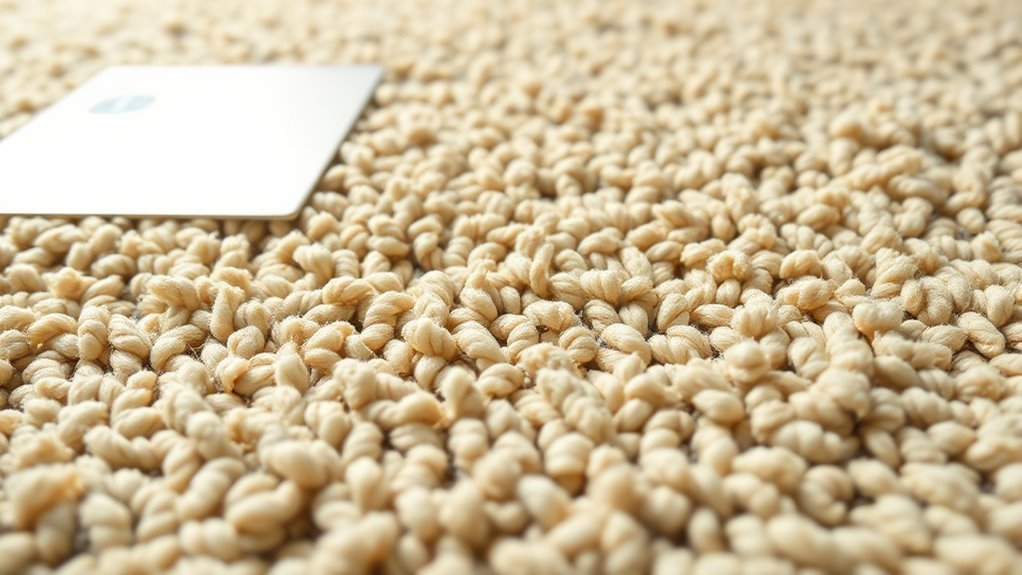
To maintain the fire safety features of your commercial carpets, regular cleaning and inspection are essential. You should vacuum frequently to remove debris that could hide damage or compromise fire-resistant treatments. Schedule professional cleanings to prevent buildup of dirt and contaminants that may weaken fibers over time. During inspections, look for fraying, burns, or areas where fire-retardant coatings may have worn away. Promptly address any issues to maintain safety standards.
| Maintenance Task | Purpose |
|---|---|
| Regular vacuuming | Removes debris, maintains fiber integrity |
| Professional cleaning | Preserves fire-resistant treatments |
| Inspection for damage | Ensures ongoing fire safety |
Frequently Asked Questions
How Do Fire Resistance Ratings Impact Carpet Installation Costs?
You might wonder how fire resistance ratings affect your carpet installation costs. Higher-rated carpets often require special treatments or fire-retardant adhesives, which can increase material and labor expenses. Additionally, meeting specific safety standards may involve extra inspections or certifications, adding to the overall cost. However, investing in fire-resistant carpets can enhance safety and potentially lower insurance premiums, making it a worthwhile consideration for commercial spaces.
Are Fire-Resistant Carpets Suitable for Outdoor Commercial Spaces?
You might wonder if fire-resistant carpets work outdoors. While they offer excellent fire safety indoors, outdoor conditions like moisture, UV exposure, and weather can compromise their durability and fire-resistant properties. It’s best to select carpets specifically designed for outdoor use, which are made to withstand the elements and still meet fire safety standards. Always check manufacturer guidelines to ensure the carpet suits your outdoor commercial space.
How Often Should Fire Resistance Testing Be Repeated?
You should repeat fire resistance testing periodically to guarantee ongoing safety compliance. Typically, testing is recommended every 1 to 3 years, depending on local regulations, usage, and manufacturer guidelines. Regular testing helps verify that the carpet still meets fire safety standards, especially after repairs or renovations. Staying proactive protects your space and occupants, so check with relevant authorities or manufacturers for specific recommendations tailored to your environment.
Can Fire-Resistant Carpets Be Recycled or Repurposed?
Think of fire-resistant carpets as resilient warriors—they’re built to withstand flames, but what happens when their battle is over? You can recycle or repurpose them, turning them into something new like insulation, padding, or craft materials. Just make certain they’re properly cleaned and free of hazardous residues. By giving these carpets a second life, you’re not only saving resources but also contributing to a greener, more sustainable world.
Do Fire Resistance Ratings Vary Across Different Geographic Regions?
You might wonder if fire resistance ratings change depending on where you are. They can, because different regions have specific fire safety standards and codes. Local regulations influence how products are tested and rated. So, a carpet meeting fire safety requirements in one country might need additional testing or certification to meet another region’s standards. Always verify local codes to ensure compliance and safety wherever you install commercial-grade carpets.
Conclusion
Just as a fortress shields its inhabitants, choosing the right fire-resistant carpet safeguards your space. By understanding ratings, testing procedures, and maintenance tips, you become your own gatekeeper against potential hazards. Remember, fire safety isn’t a mere label—it’s an ongoing commitment, much like tending a flame to ensure it stays contained. Equip yourself with knowledge, and your commercial space will stand resilient, prepared to face any challenge that comes its way.
